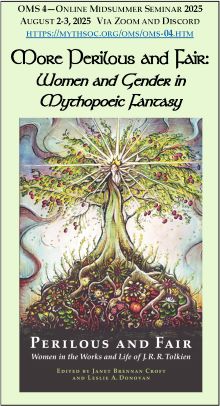Loading...
Document Type
Paper
Event Website
http://www.mythsoc.org/mythcon/mythcon-51.htm
Start Date
31-7-2021 1:30 PM
End Date
31-7-2021 2:15 PM
Description
In this paper, adapted from the second chapter of my Master’s thesis, I will argue that Tolkien was not interested in mimicking Norse mythology nor endorsing the Nordic worldview, but rather re-writing Norse mythology in accord with its true light. This concept of “true light” is drawn from a letter by Tolkien to his son Michael in which he laments the corruption of “that noble northern spirit, a supreme contribution to Europe, which I have ever loved, and tried to present in its true light” (Carpenter, Letters 56). Tolkien had an Augustinian conception of evil, believing that good is primary, evil secondary. Therefore, a good thing like Northern courage, in Tolkien’s view, could be corrupted, yet beneath that corruption, it still retained its true light. The true light of Northern Courage was, in Tolkien’s view, something worthwhile which he desired to see redeemed.
This project is clearly demonstrated in The Legend of Sigurd and Gudrun, where Tolkien tampers with the saga at such a foundational level that it is hardly appropriate to still refer to the poem as Norse. The Legend of Sigurd and Gudrun follows the familiar character of Sigurd along his well-documented quest, led on his way by a god named Odin, but Tolkien’s poem takes liberties with the story that shake it—thematically—to its core. The Nordic worldview, characterized by its distinct theory of courage, was a worldview entirely built around the idea that the earth and everyone in it was doomed to ultimate defeat along with their gods, and their response, as modeled by Odin and the rest of the Aesir, was to defiantly fight on to the bitter end. The Nordic worldview was one that acknowledged that the world was a cold, brutal place full of cruel and violent people, all predestined for suffering and destruction without even the hope that their gods might save them: a bleak and demoralizing prospect to say the least. Yet, the ancient Norse were known as hardy, relentlessly courageous people, despite their gloomy worldview. Though they acknowledged the bleakness of their position, they were determined to go down to the grave laughing defiantly, with heads held high until the very last. This, in a nutshell, is Northern courage. Yet, in Tolkien’s “New Lay of the Volsungs,” he inserts a messianic promise of redemption and suggests that death in fact will be overcome, even if it is not entirely clear how. On the surface, this insertion may seem a small detail considering how few lines are actually dedicated to it, but it is a detail which undermines the entire tapestry of Norse mythology, a move which cannot be mistaken as a mere mistake or misunderstanding coming from a student of Norse language and literature such as Tolkien. Tolkien’s subversive addition was a calculated move and part of his project to rewrite Norse mythology in order to present Northern courage in its true light.
Tech Mod: Jessica Dickinson Goodman.
Creative Commons License

This work is licensed under a Creative Commons Attribution-NonCommercial-No Derivative Works 4.0 International License.
Included in
A Saga Re-Written: The Character of Odin and J.R.R. Tolkien's Addition of Eucatastrophe in "The New Lay of the Volsungs."
In this paper, adapted from the second chapter of my Master’s thesis, I will argue that Tolkien was not interested in mimicking Norse mythology nor endorsing the Nordic worldview, but rather re-writing Norse mythology in accord with its true light. This concept of “true light” is drawn from a letter by Tolkien to his son Michael in which he laments the corruption of “that noble northern spirit, a supreme contribution to Europe, which I have ever loved, and tried to present in its true light” (Carpenter, Letters 56). Tolkien had an Augustinian conception of evil, believing that good is primary, evil secondary. Therefore, a good thing like Northern courage, in Tolkien’s view, could be corrupted, yet beneath that corruption, it still retained its true light. The true light of Northern Courage was, in Tolkien’s view, something worthwhile which he desired to see redeemed.
This project is clearly demonstrated in The Legend of Sigurd and Gudrun, where Tolkien tampers with the saga at such a foundational level that it is hardly appropriate to still refer to the poem as Norse. The Legend of Sigurd and Gudrun follows the familiar character of Sigurd along his well-documented quest, led on his way by a god named Odin, but Tolkien’s poem takes liberties with the story that shake it—thematically—to its core. The Nordic worldview, characterized by its distinct theory of courage, was a worldview entirely built around the idea that the earth and everyone in it was doomed to ultimate defeat along with their gods, and their response, as modeled by Odin and the rest of the Aesir, was to defiantly fight on to the bitter end. The Nordic worldview was one that acknowledged that the world was a cold, brutal place full of cruel and violent people, all predestined for suffering and destruction without even the hope that their gods might save them: a bleak and demoralizing prospect to say the least. Yet, the ancient Norse were known as hardy, relentlessly courageous people, despite their gloomy worldview. Though they acknowledged the bleakness of their position, they were determined to go down to the grave laughing defiantly, with heads held high until the very last. This, in a nutshell, is Northern courage. Yet, in Tolkien’s “New Lay of the Volsungs,” he inserts a messianic promise of redemption and suggests that death in fact will be overcome, even if it is not entirely clear how. On the surface, this insertion may seem a small detail considering how few lines are actually dedicated to it, but it is a detail which undermines the entire tapestry of Norse mythology, a move which cannot be mistaken as a mere mistake or misunderstanding coming from a student of Norse language and literature such as Tolkien. Tolkien’s subversive addition was a calculated move and part of his project to rewrite Norse mythology in order to present Northern courage in its true light.
Tech Mod: Jessica Dickinson Goodman.
https://dc.swosu.edu/mythcon/mc51/schedule/10



Comments
Recorded Session